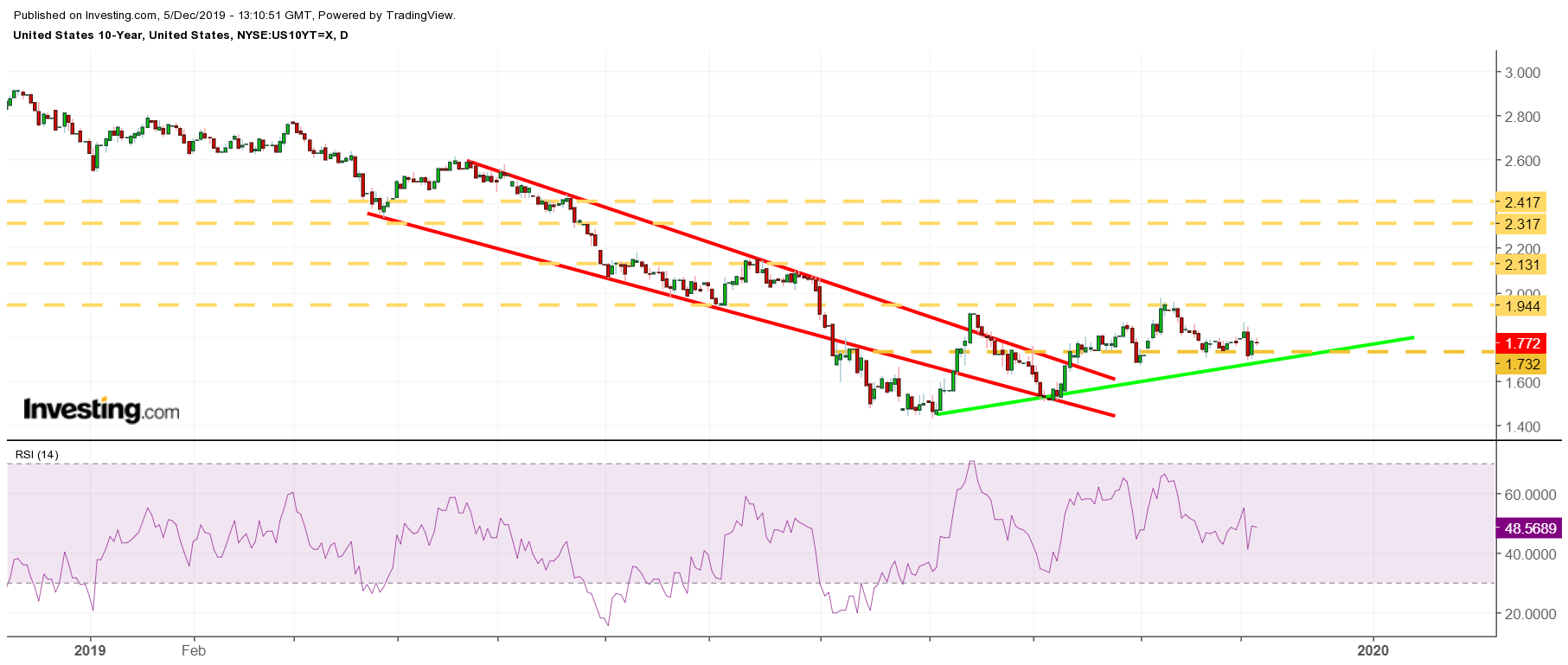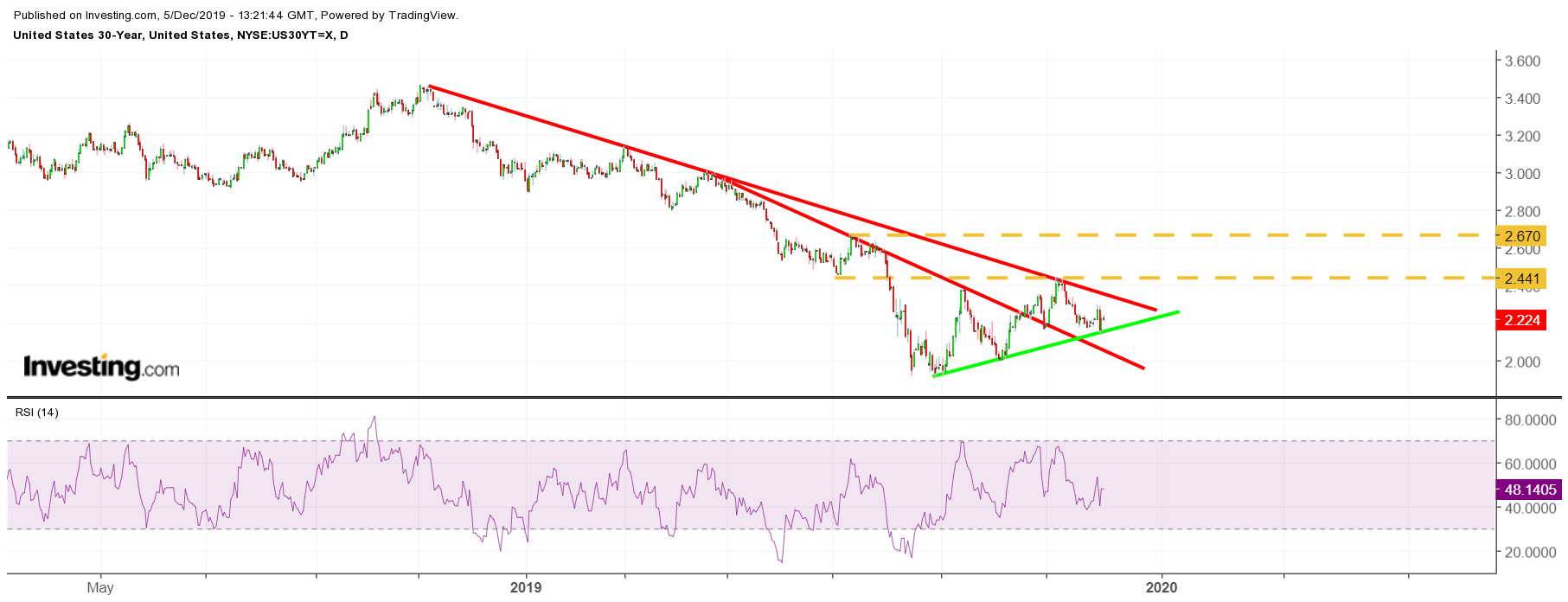Why U.S. Rates Could Be Heading Higher In 2020 After Plunging In 2019
Michael Kramer | Dec 06, 2019 03:20AM ET
This post was written exclusively for Investing.com
Interest rates have plunged in 2019, with the U.S. 10-year and 30-year yields both falling to their lowest levels in years: the former to the lowest since 2016 and the latter to the lowest ever. It became clear by late August that rates had bottomed. Now, yields may be on a path that sends the 10-year rate higher towards 2.15% and the 30-year yield to as high as 2.65%, amounting to an increase of approximately 40 basis points each, respectively.
The technical charts for both rates have formed technical reversal patterns that support the increase. Also, supporting higher yields are the spreads between U.S. and German bonds, which have dropped to their lowest levels since January 2018, while spreads between U.S. and Japanese bonds have contracted to their lowest level since late 2016. For those spreads to hold steady, U.S. rates will at least need to keep pace with rising yields in both countries.
U.S. Yields May Be Heading Higher
The 10-year yield fell to a low of roughly 1.45% in late August, but had been grinding lower since April. It created a technical pattern known as a falling wedge, a reversal pattern. The rate on the 10-year then broke the downtrend in the middle of October and pushed to a level of technical resistance at roughly 1.95%. However, there is now a clear uptrend that has formed in the 10-year, and should it rise above resistance, it is likely to move to its next significant level of resistance at around a rate of 2.15%.

Meanwhile, the 30-year yield formed a reversal pattern, known as a bump and run. This can be seen with the 30-year rate of decline accelerating at the end of April and bottoming in August. Now the 30-year is trending higher, like the 10-year, and should it rise above a downtrend at a rate of approximately 2.3%, the interest rate could increase to around 2.45%. However, a rise above 2.45% could result in the rate climbing to as high as 2.67% in 2020.

Spreads Narrow
Another indication that rates may be heading higher in the U.S. is that the spreads between U.S. and German yields have contracted to levels not seen since January 2018. Additionally, the spread between U.S. and Japanese 10-year rates has narrowed to levels not seen since November 2016.
More interesting is that the spread on the U.S. and Japanese bonds appear to be hitting a region of resistance that would suggest the difference will shrink further. The pattern seems to be forming a continuation pattern known as a rising triangle. This is an indication that the spread will continue to narrow, which means if Japanese yields continue to rise, as they have since the end of August, then U.S. yields would need to increase too, in order to keep pace with higher yields in Japan and avoid the spread reversing and widening again.
The same is happening with spreads between the U.S. and Germany. Yields in Germany have been on the rise as well and, to keep the spread neutral or to see it contract further, rates in the U.S. would need to rise to stay in step.
Global Growth to Return?
It is a bold and risky call to suggest that rates will rise in 2020, especially given the pessimism that persists around the global growth outlook among investors. However, there has been some recent data to suggest that the economy in the Eurozone may be on the mend based on better-qtrending manufacturing PMI data, while Japan has recently launched a $121 billion stimulus plan, its largest in three years.
Even if yields do rise in 2020, it is important to remember they are coming off extremely low levels in 2019 and aren’t likely to pose a significant threat to the global equity markets or a global economic recovery.
Trading in financial instruments and/or cryptocurrencies involves high risks including the risk of losing some, or all, of your investment amount, and may not be suitable for all investors. Prices of cryptocurrencies are extremely volatile and may be affected by external factors such as financial, regulatory or political events. Trading on margin increases the financial risks.
Before deciding to trade in financial instrument or cryptocurrencies you should be fully informed of the risks and costs associated with trading the financial markets, carefully consider your investment objectives, level of experience, and risk appetite, and seek professional advice where needed.
Fusion Media would like to remind you that the data contained in this website is not necessarily real-time nor accurate. The data and prices on the website are not necessarily provided by any market or exchange, but may be provided by market makers, and so prices may not be accurate and may differ from the actual price at any given market, meaning prices are indicative and not appropriate for trading purposes. Fusion Media and any provider of the data contained in this website will not accept liability for any loss or damage as a result of your trading, or your reliance on the information contained within this website.
It is prohibited to use, store, reproduce, display, modify, transmit or distribute the data contained in this website without the explicit prior written permission of Fusion Media and/or the data provider. All intellectual property rights are reserved by the providers and/or the exchange providing the data contained in this website.
Fusion Media may be compensated by the advertisers that appear on the website, based on your interaction with the advertisements or advertisers.